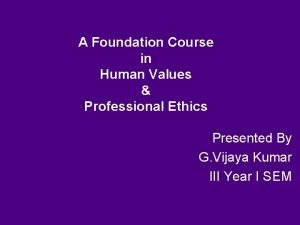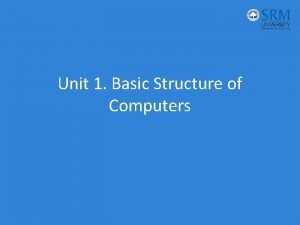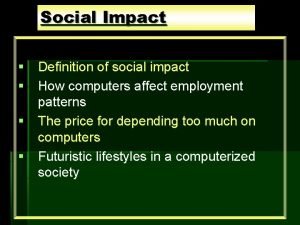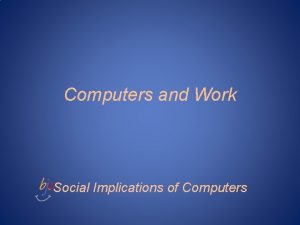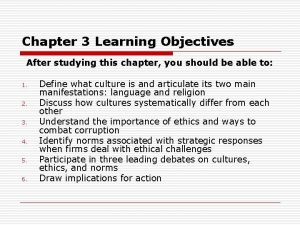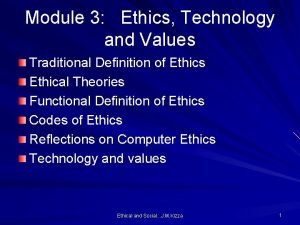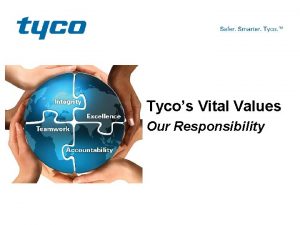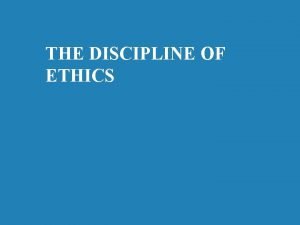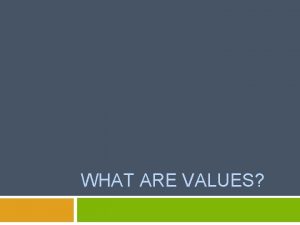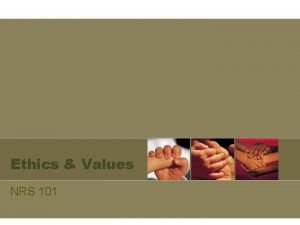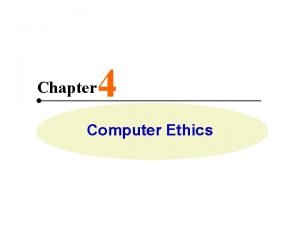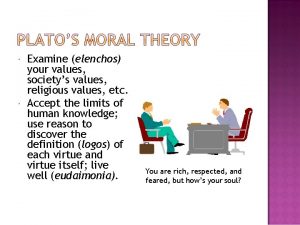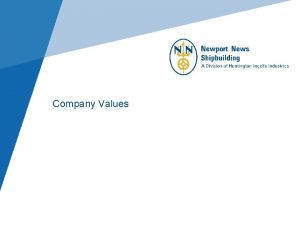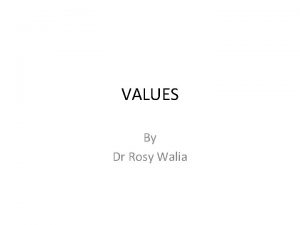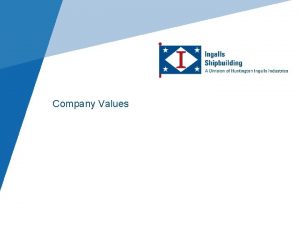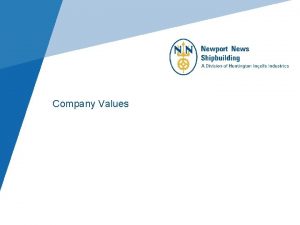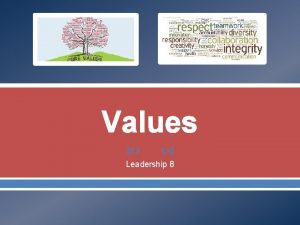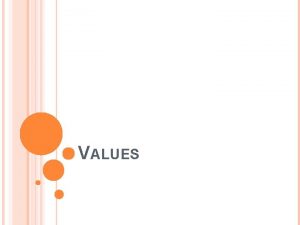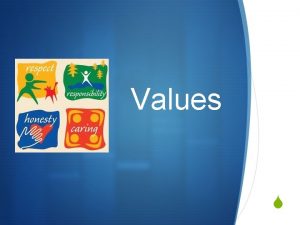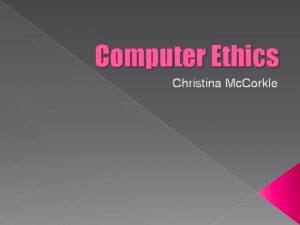Computers Ethics and Social Values What is Computer


















- Slides: 18

Computers, Ethics, and Social Values What is Computer Ethics?

Introduction • Definition of computer ethics • Rationale for studying computer ethics – Technology is entrenched in our society, ethical questions arise regarding the uses of this new technology – Are these ethical issues pertaining to computer professionals new or are these the same issues in a different guise?

James Moor • Professionals face new ethical questions because the use of computer technology • "vacuum of rules or policies" leaves these computer professions with no guidance • Advocates a coherent conceptual framework within which to formulate a policy for computer ethics • Unique

Computer Revolution • Introduction stage -Computers have been refined • Permeation stage -Computers are an integral part of life -Practical importance for computer ethics

Invisibility factor • Invisible abuse -Invisible operations of the computer are used for unethical conduct • Invisible programming values -Programmer values are put into the program which may include a programmer's bias • Invisible complex calculation -Computers can perform a tremendous number of calculations

John Barlow "Coming into the County" • Cyberspace - a vast continent with no end to its dimensions • Need for "new social contracts for the digital domain" • Concern for: privacy issues, freedom of expression, economic opportunity, and property rights, cultural implications of the technology

Donald Gotterbarn Responsibility Regained • Little progress due to no "coherent concept of the subject" • Computer ethics should focus on the actions that lie within the "control of individual moral computer professionals" • Not Unique • Computer ethics as rules and judgments professionals make within specific contexts

• Ethical rules and judgments are "applied in a computer context based on professional standards and a concern for the user of the computing product” • Two spheres: - ethical problems that can be reasoned by "analogy with other traditional ethical problems" - ethics for computing professionals • Welfare of the user - service industry • No organization to control membership or sanction violations

Terry Winograd • “Integrate computer technology and human values in such a way that the technology advances and protects those values rather than doing damage to them“ • Intention plays a large role in how an action is interpreted • Must consider context when assessing an ethical issue

• "domain in which an action is assessed is not necessarily the same as the domain in which the actor interprets it" • Three components in "doing" ethics -identifying social/ethical issues -entering into serious discourse about the possibilities -taking actions.

Ethics in Society • Society – An association of people organized under a system of rules designed to advance the good of its members over time – Morality: Rules of conduct describing what people ought and ought not to do – Ethics: Philosophical study of morality, a rational examination into people’s moral belief’s and behavior

Robert Collins and Keith W. Miller • Paramedic Method - Procedure for analyzing a particular ethical situation • Professional must determine an ethical course of action from three different perspectives: – a deontological approach – a social contract – and utilitarian approach

• Ethical decision leading to the "most opportunity and least vulnerability for most parties" • Social Contracts - negotiation and consensus as tools • Deontological is concerned with rights and obligations. Giving someone rights creates obligations. • Utilitarian is thinking of the "greater good of society. "

• Four-step process with similarities to the Waterfall Method of software design 1. 2. 3. 4. Gathering Data Analyzing Data Negotiating an Agreement Judging Data

Case Study • • The past several months, George, an electrical engineer working for an aerospace contractor, has been the quality control manager on a project to develop a computerized control system for a new military aircraft. Early simulations of the software for the control system showed that, under certain conditions, instabilities would arise that would cause the plane to crash. The software was subsequently patched to eliminate the specific problems uncovered by the tests. After the repairs were made, the system passed all of the required simulation tests. George is convinced, however, that those problems were symptomatic of a fundamental design flaw that could only be eliminated by an extensive redesign of the system. Yet, when he brought his concern to his superiors, they assured him that the problems had been resolved, as shown by the tests. Anyway, to reevaluate and possibly redesign the system would introduce delays that would cause the company to miss the delivery date specified in the contract, and that would be very costly. Now, there's a great deal of pressure on George to sign off on the system and allow it to be flight tested. It has even been hinted that, if he persists in delaying release of the system, the responsibility will be taken away from him and given to someone who is more compliant. . What makes the situation so difficult for George is that he must choose between conflicting duties: loyalty to self, family, employer, and superiors versus the obligation to tell the truth and to protect others from harm. . .

Obligation Relations

ACM "Code of Ethics and Professional Conduct. " 1) General Moral Imperatives addresses ethical issues of honesty, individual contribution to the well being of society, nondiscrimination, property rights, intellectual property, privacy, and confidentiality. 2) Specific Professional Responsibilities addresses issues of effectiveness of process and products, maintaining professional competence, respecting existing laws, accepting professional review, comprehensive evaluations of computer systems to assess impacts and risks, honoring contracts, improving understanding of computing, accessing computer communication only when authorized. While the first six items in this section can be applied generally to other professions, the last two items address computing specifically. 2. 7 Improve public understanding of computing and its consequences. 2. 8 Access computing and communication resources only when authorized to do so.

• 3) Organizational Leadership addresses encouraging members to accept full social responsibility, design and build systems that enhance working lives, thorough assessment of user needs when analyzing and designing systems, protecting the dignity of users, promote the learning of principles and limitations of computing. This section is extremely important because it places some obligations on management to create an environment where a computer professional can be ethical. Without these management responsibilities the preceding two sections could become impossible to obtain. • 4) Compliance with the Code contains 2 items. The first item directs members to be supportive of others. The second item indicates that gross misconduct is grounds for dismissal. It also makes a major point: "Adherence of professionals to a code of ethics is largely a voluntary matter. "
 Bruce maglino workplace values
Bruce maglino workplace values An individual's enduring tendency to feel
An individual's enduring tendency to feel Chapter 22 ethics and values
Chapter 22 ethics and values Cbsa values and ethics
Cbsa values and ethics Conservation values and ethics
Conservation values and ethics Foundation course in human values and professional ethics
Foundation course in human values and professional ethics Elements of computer
Elements of computer Basic structure of computers
Basic structure of computers Micro and macro issues in engineering ethics
Micro and macro issues in engineering ethics Social impact of computers
Social impact of computers Social implications of computers
Social implications of computers Western vs eastern values
Western vs eastern values What are the two possible values of a bit
What are the two possible values of a bit Concept of value
Concept of value Technology and values
Technology and values Definition of values in ethics
Definition of values in ethics Vital values
Vital values Descriptive ethics
Descriptive ethics Briefly recap
Briefly recap





